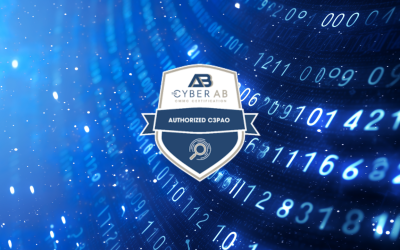Key Takeaways
- Educate personnel to become proactive cybersecurity defenders through effective awareness and training as outlined in NIST SP 800-171.
- Incorporate security awareness and training based on assigned duties, roles, and responsibilities that not only protect internal systems but also extend vigilance to third-party entities within a supply chain.
- Provide insights on different types of insider threats, identify potential insider threats, and effectively report threats.
Elevating Cybersecurity Through Awareness and Training
In an era dominated by digital threats, cybersecurity is not just about having robust systems but it is also about having a workforce who is aware and trained. Understanding and implementing the guidelines of NIST SP 800-171 is crucial in enforcing this vital security measure. As we navigate the complexities of cybersecurity risk management, awareness and training emerges as a key pillar in building a resilient defense against evolving threats. This focus on employee education and compliance forms the foundation of our discussion on NIST SP 800-171.
Fostering a Culture of Security Awareness.
As the cybersecurity landscape evolves, so must our security vigilance. As emphasized in NIST SP 800-171, nurturing a culture of awareness and training within organizations is essential. This shift towards creating an environment where every team member is equipped and aware of their role in cybersecurity is pivotal. Creating an environment around security awareness allows an organization to go from a reactive stance to a more effective proactive stance, ensuring the awareness of potential threats and the training to address them are embedded in the daily operations of the organization.
Cultivating Cyber Resilience
The Role of Awareness and Training in NIST SP 800-171
NIST SP 800-171’s section 3.2.1 underscores the importance of educating managers, system administrators, and users about the risks of their activities and the related security policies. Effective training covers a wide range of topics ranging from identifying phishing attempts to implementing strong password policies. It’s about instilling a mindset where security is essential to every action within the organization.
Interactive training sessions, regular security updates, and simulated cyber-attack exercises play a crucial role in keeping the team engaged and prepared. The goal is to develop a workforce that is not only aware of cyber risks but also actively works to mitigate them. Consequently, transforming each member of the organization into a knowledgeable and vigilant participant in the cybersecurity program is essential, moving beyond mere compliance to fostering a culture of shared responsibility and continuous learning.
Understanding the Importance of NIST 3.2.2
Recognizing the importance of training individuals within an organization is why NIST 3.2.2 emphasizes role-based security training. Organizations are responsible for creating security-related technical training content as well as defining the frequency of training. This training must apply to every personnel who has access to system-level software. Each role should have tailored content adhering to the organization’s security requirements and a defined frequency of training. Comprehensive training topics include: policies, procedures, tools, and artifacts for the defined security roles.
Recognizing and Reporting Potential Indicators of Insider Threat
Insider threats are responsible for a significant portion of security breaches. Early detection and reporting can help minimize damage, protect sensitive information, and prevent potential harm. There are three main types of insider threats: 1) malicious – where the person intentionally targets to harm the organization for personal gain; 2) negligence – where the person unintentionally compromises security due to carelessness, lack of awareness, or poor security practices; and 3) complicity – where the person knowingly cooperates with individuals who intend to harm the organization.
Indicators of insider threat include: behavioral changes (dramatic shifts in work ethics, sudden increased interest in sensitive data, attempting to access systems during unusual hours, or downloading large amounts of data), and financial changes (unexplained wealth or sudden changes in lifestyle or misuse of technology, attempting to bypass security controls, installing unauthorized software, or using personal devices for work purposes).
Reporting insider threat activities can prevent serious harm or damage to the organization’s assets including information, people, and equipment. Reporting best practices include reporting to established personnel within the organization and not to the suspected individual. Follow the organization’s policies for reporting security concerns whether through a dedicated hotline or a reporting system. Provide specific details, including dates, times, actions, and any other relevant information observed. Remember to maintain confidentiality while doing so and do not share this information with unauthorized individuals.
Advancing Towards Comprehensive NIST SP 800-171 Compliance with Awareness and Training
Comprehensive awareness and training are not mere regulatory checkboxes but are foundational elements that strengthen every aspect of an organization’s cybersecurity posture. It is crucial in understanding that cybersecurity defenses are only as strong as the weakest link in the supply chain. We all have a role to play in protecting the organization from insider threats. By being aware of the indicators, reporting suspicious activities, and following security best practices, we can help keep data, systems, and people safe.
These are just a few examples of how to implement Awareness and Training whether you are a DoD Contractor or part of the Defense Industrial Base (DIB). Look for our next blog on Audit and Accountability.
Stay Ahead of the Game: Ensure Your NIST SP 800-171 Compliance for DoD Contracts
IBSS will use our 20 years of corporate DoD cybersecurity experience to prepare you for NIST SP 800-171 compliance. We specialize in developing cybersecurity strategies that align with organizational business processes to detect or prevent cyber attacks. We identify threats and vulnerabilities, and we assist organizations with managing risks to critical data. We provide expert support to promote compliance with Defense Federal Acquisition Regulation Supplement (DFARS), Federal Information Security Modernization Act (FISMA), Federal Risk and Authorization Management Program (FedRAMP), NIST SP 800-171, and Privacy requirements.
Contact us now to get a free consultation on how to develop your company’s NIST SP 800-171 SSP.





